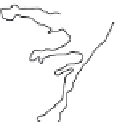Environmental Engineering Reference
In-Depth Information
(a)
125-year-old
lava flow
N
37-year-old
lava flow
16-year-old
lava flow
700
600
500
400
300
200
100
2 km
(b)
0-
year-
old
16-
year-
old
37-
year-
old
125-
year-
old
800-
year-
old
Bare
land
Alnus
shrub
Machilus
and
Prunus
forest
Castanopsis
forest
Fig. 8.1
(a) Locations of sampling sites on 16-, 37- and 125-year-old lava fl ows on Miyake-
jima Island, Japan. Sites outside these fl ows are at least 800 years old. Altitudinal contours
are shown in meters. (b) In the earliest stage of succession, soil was sparse and lacking in
nitrogen, an essential plant resource: the only vegetation consisted of a few small alder trees
(
Alnus sieboldiana
). In the older plots (37-800 years old), 113 species were recorded,
including ferns, herbs, lianas and trees. This primary succession consisted of: (i) coloniza-
tion of the bare lava by the nitrogen-fi xing alder; (ii) facilitation (through improved nitrogen
availability) of mid-successional
Prunus speciosa
and the late-successional evergreen tree
Machilus thunbergii
; (iii) establishment of a mixed forest in which
Alnus
and
Prunus
were
shaded out (i.e. outcompeted); and (iv) competitive replacement of
Machilus
by the longer
lived
Castanopsis sieboldii
. (After Kamijo et al., 2002.)
et al., 2001). In addition, some early species change the abiotic environment in ways (e.g. by pro-
viding shade or improving soil quality) that make it easier for later species to establish and thrive
- this is known as facilitation. A fi nal species interaction may also play an important role in deter-
mining the course of succession. Predation, whether of seeds or mature vegetation, can slow or
stop a successional sequence in its tracks. Thus, apart from competition-colonization trade-off,
successional niche and facilitation, we have to add a fourth mechanism - interactions with enemies
- to fully understand ecological succession.
The concept of the successional mosaic and the central role of disturbance
Some disturbances are on a very large scale. Thus, thousands of hectares of forest may be simul-
taneously destroyed by a fi re caused by lightning or by a careless camper. The subsequent suc-
cessional sequence starts at the same time over this large area and proceeds more or less in
synchrony. However, a forest that appears to have reached a stable community structure when
studied on a large scale will always be a mosaic of miniature successions. And the same is true
for a grassland or rocky shore community. Every time a tree falls, a grass tussock dies or a boulder
is turned over, an opening is created in which a new mini-succession starts. The resulting spatio-
temporal pattern is called a successional mosaic.
The frequency with which disturbance occurs infl uences the patchy nature of the successional
mosaic. But it also helps determine the total number of species in the area. Where disturbances









































Search WWH ::

Custom Search